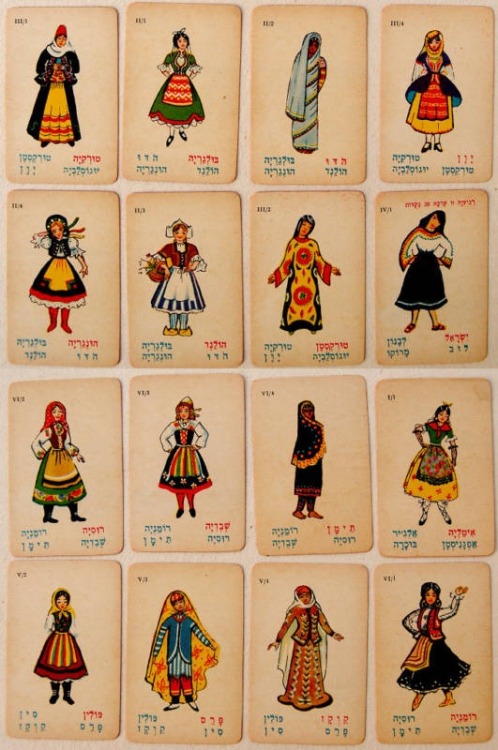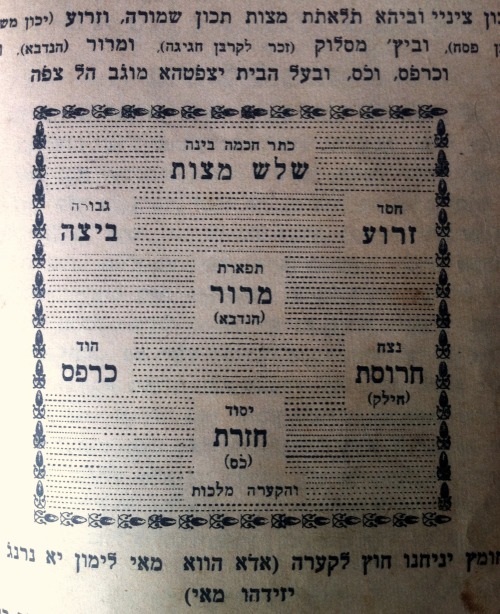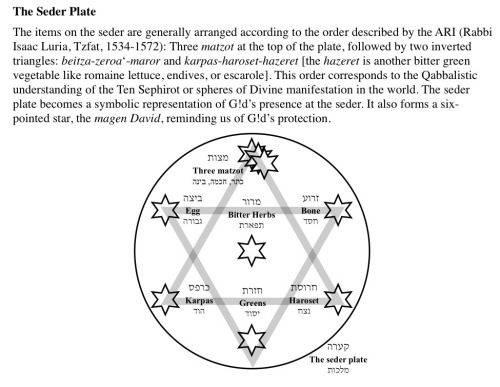#sephardi
Vintage set of playing cards depicting Jewish women’s folk costumes from around the world. The countries, fro right to left, are as follows:
First row: Turkey, Bulgaria, Hodu (India), Yazan (Wiesen; could be Switzerland, Austria, or Bavaria, apparently)
Second row: Hungaria, Holland, Turkmenistan, Israel
Third row: Russia, Serbia (fun fact: for a second I misread it as Siberia), Teiman (Yemen), Italy
Fourth row: Poland, (This one I can’t entirely read, but I think it says Paras, or Persia. Interestingly, it looks more like Uzbek clothing), Kavkaz (the Caucasus), Romania
Post link
Arranging the Seder Plate in Judeo-Arabic Tradition
I have a (modest but growing) collection of vintage haggadot with Judeo-Arabic translation, and they contain a lot of fascinating information not just about different dialects and vocabularies of Judeo-Arabic (which is why I originally started) but also about Passover traditions in general.
One common image or diagram at the front is the arrangement of the seder plate, called in some traditions as-sistuorat-tabaq oras-siniya in others. Many North African communities used a reed basket rather than the metal or porcelain tray common in other traditions. The items on the seder plate, as you see, are arranged in a Qabbalistic formation which corresponds to the ten sephirot:
- The three matzot for keter,hokhma, and bina.
- The egg (al-bayda) for gevurah and the shankbone (ad-dra’) for hesed.
- Themaror (translated in one haggada as hinduba, “chicory”) for tiferet.
- Thekarpasforhod and the haroset (known as hileqorhaliq in Iraqi tradition) for netzah.
- Thehazeretforyesod.
- The seder plate itself representing the lowest sephira,Malkhut.
The haggadot here are:
1. Algerian (printed in Livorno), 1856.
2. Tunisian (printed in Tunis), 1930s or 40s.
3. Algerian (printed in Vienna), 1890.
4. Moroccan (printed in Casablanca), 1930s or 40s
5. Iraqi (printed in Jerusalem), 1940s.
6. My own summary and diagram, from this booklet, 2012.
Post link
Siddur Masorti - Egalitarian + Sefaradi
Announcing Siddur Masorti , a new Səfaradi egalitarian prayer book. Inside you’ll find the weekday prayer service with…
- A *full* transliteration
- A groundbreaking new gender-neutral translation
- A Hebrew text inclusive of all genders
- Breathtaking calligraphic artwork
- Options designed to include as many different Səfaradi traditions as possible.
Go to siddurmasorti.com or click the ‘Shop Now’ button on our page to pre-order your copy now.
*Pre-orders open 2 Oct and orders placed will ship after our launch on 3 November* *Free shipping in the UK*
[ ] in the source link below, you’ll gain access to #151 gifs of jenny slate in joshy (2016) and on the rocks (2020). she was born in the year 1982 and is of european (ashkenazi, sephardi) descent, so please cast appropriately when using my resources. all of these gifs were made from scratch, so you may edit these as much as you’d like, but please don’t redistribute or claim as your own. please refer to my rules for further information.
- note: this pack is completely free and is also accessible through a zip file.



Salonique 1917: Le Quartier israëlite détruit. Special Collections Research Center DS 135 .G72 T41 Q37 1917


Salonique: Incendie des 18-19-20 Août 1917 DS 135 .G72 T41 I53 1917
“Located between the Mediterranean Sea and the Balkan Peninsula, the port city of Salonica (Thessaloniki), Greece, is in the intersection of two different climatic zones – a geographic situation that creates high variations in atmospheric pressure during the year. In several occasions through the centuries, the strong winds that blow from the north down the Vardar valley whipped up fires that quickly spread, causing significant damage and devastation in the city. The fire that sparked in Salonica on Saturday, August 18, 1917 was of unprecedent scale and changed completely the physiognomy of the city. The fire burned a large part of the historic city center, where several predominantly Jewish neighborhoods were located, leaving a large part of the city’s population homeless – approximately 56,000 Jews, 15,000 Christians, and 10.000 Muslims had their houses consumed by the fire. After the fire, a new urbanistic plan was implemented under the leadership of two famous architects, Ernest Hébrard of France and Thomas Mawson of England. The majority of the Jewish residents who lost their houses, now impoverished, were transferred to peripheral areas of the town, such as the Regie Vardar and Campbell districts. Dozens of postcards depicted the great fire of 1917, including the two featured here, which were purchased by the Special Collections Research Center with the generous support of the Lucius N. Littauer Foundation and the Solovy Judaica Book Fund.” Read more!









